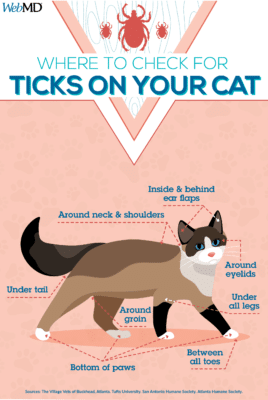
We know that ticks are vectors of terrible diseases like Lyme and Rocky Mountain spotted fever in humans. But what about cats? In this blog, we’ll explore what diseases ticks spread to cats, how to spot them, and how to prevent your cat from getting them in the first place. You want to keep your feline friends safe, and Modern wants to help.
Our Pets are at Risk
Some people incorrectly think that cats can’t get diseases from ticks. Black-legged (deer) ticks, American dog ticks, brown dog ticks, and lone star ticks will all take a blood meal from a cat. Ideally, your feline friend is an indoor cat. There are many threats even more dangerous than ticks that cats can encounter outdoors. But even an indoor cat can get a tick from the humans and dogs he lives with. Year-round tick prevention or breakaway tick collars are important for outdoor cats. And all dogs that go outside should be treated year-round as well. Talk with your veterinarian about the best preventative treatment for your cats and dogs.
Our Homecare Mosquito, Flea, and Tick Program is proven to effectively reduce populations of all three vector pests! Get a quote or schedule service today!
The Diseases
Here are six of the tick-borne diseases that are a threat to cats:
- Lyme Disease
Lyme disease is caused by the bacteria Borrelia burgdorferi. Some black-legged or deer ticks carry the bacteria and transmit it to another animal while feeding on its blood. The tick needs to be attached to a cat for about 48 hours to transmit the bacteria to the cat. That’s why a daily tick check is important this time of year. Symptoms of Lyme disease include fever, swollen lymph nodes and joints, a reduced appetite, and acting like they’re in pain. If left untreated, Lyme can result in kidney disease and heart and nervous system disorders. While there is no Lyme vaccine for cats, antibiotics can be used to treat it once diagnosed.
- Anaplasmosis
Anaplasmosis is spread in New England by black-legged or deer ticks. There might not be any signs in an infected cat for one or two weeks. Things to watch for are limping, difficulty walking due to sore and stiff joints, weakness, fever, lethargy, loss of appetite, and weight loss. It’s important to get your cat to the vet as soon as possible so he can begin a course of antibiotics. The longer you wait, the worse the infection can become.
- Haemobartonellosis
Haemobartonellosis is also known as feline infectious anemia. It is transmitted by both ticks and fleas and it targets red blood cells. This leads to anemia and weakness in cats (it affects dogs, too). It is treated with weeks of antibiotics and sometimes requires transfusions.
- Tularemia
Tularemia can be transmitted by American dog ticks and lone star ticks in New England. Fleas can also transmit the disease. It’s sometimes called rabbit fever and affects cats more than dogs. Symptoms in cats include high fever, swollen lymph nodes, nasal discharge, and sometimes an abscess at the site of the tick bite. Like Lyme, there is no vaccine for tularemia. It is treated with antibiotics.
- Babesiosis (Piroplasmosis)
Cats contract babesiosis when an infected tick transmits protozoa parasites to him and they go after red blood cells. This causes anemia in the cat. Symptoms include depression, pale gums, dark-colored urine, fever, and swollen lymph nodes. If it becomes severe, the cat might collapse and go into shock. Treating babesiosis requires a prescription drug called primaquine phosphate. The drug kills off protozoa parasites that are infecting your cat. There is no vaccine available.
- Cytauxzoonosis
Cytauxzoonosis is most commonly reported in the south-central and southeast United States. Cats with cytauxzoonosis may develop anemia, depression, high fever, difficulty breathing, and jaundice (yellowing of the skin). There is no vaccine and cats who survive the disease might be carriers for life. Treatment is often unsuccessful, and death can occur within a week following infection. Specialized drugs, IV fluids, and supportive care are necessary.
Our Homecare Mosquito, Flea, and Tick Program is designed to focus on the areas of your property that your family and pets frequent when enjoying the outdoors. Click here or call Modern at 1-800-323-7378 to get a free quote or schedule service today!
How to Prevent Tick-borne Diseases in Cats
The easy answer is to prevent cats from encountering ticks at all. But that’s not always feasible when the cat’s human and dog housemates are potentially bringing them inside. Tick checks are an important method of keeping your cat healthy. This should be done every day or two from April through September, which is the height of tick season in New England. Also, speak with your veterinarian about preventative treatments like collars and topical solutions. Be sure to do the same for any dogs that live in your home, as they’re also susceptible to many tick-borne illnesses.

The Modern Solution
Another way to protect the animals and humans who live at your house from the tick threat is by calling Modern Pest. Modern’s Homecare Mosquito, Flea, and Tick service provides a meaningful reduction in the tick population. Our licensed Service Professionals target the areas where ticks breed and take shelter. Using low-toxicity yet highly effective materials, we treat all harborage areas on your property. The goal is to eliminate adult populations and prevent further reproduction, limiting the number of insects that could cause harm to your human and animal family. Call Modern today at 1-800-323-7378 to sign up for our service.
